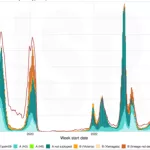April 8, 2024
Frontotemporal dementia (FTD), a form of dementia affecting individuals under the age of 65, is characterized by profound changes in personality, behavior, and language. Now, groundbreaking research led by Mayo Clinic sheds light on a protective genetic variant associated with FTD and unveils a potential mechanism underlying disease progression. Published in the journal Science Translational Medicine, the study offers hope for improved treatments and diagnostic tools for this devastating condition.
Researchers have long recognized a less common protective variant of the TMEM106B gene, known to slow FTD progression. However, the exact mechanism by which this variant exerts its protective effect has remained elusive. The latest findings suggest a link between the protective TMEM106B variant and the formation of fibrils—tiny fiber-like structures produced by part of the TMEM106B protein—in the brain.
Dr. Jordan Marks, an M.D.-Ph.D. student and lead author of the study, underscores the significance of their discovery: “Our research provides compelling evidence that genetic variants in TMEM106B play a crucial role in FTD progression. We observed a striking absence of fibril buildup in individuals with the protective TMEM106B variant, suggesting a potential mechanism by which this variant mitigates disease progression.”
The study, which analyzed brain tissue samples from over 250 deceased FTD patients, revealed a positive correlation between the presence of TMEM106B fibrils and the abundance of another pathological protein associated with FTD, called TDP-43. Importantly, individuals harboring the protective TMEM106B variant exhibited minimal fibril accumulation, indicating a slower disease course.
Dr. Casey Cook, a Mayo Clinic neuroscientist and co-corresponding author of the paper, emphasizes the clinical implications of their findings: “Our research underscores the importance of considering genetic variants in TMEM106B in FTD studies. Furthermore, it opens new avenues for therapeutic interventions aimed at preventing fibril buildup and slowing disease progression.”
The study also suggests that TMEM106B fibrils could serve as potential biomarkers for FTD prognosis and severity, offering clinicians valuable insights into disease progression and guiding treatment decisions.
In a related study published in Science Advances, Mayo Clinic researchers identified novel peptides associated with dysfunctional TDP-43—a protein implicated in both FTD and amyotrophic lateral sclerosis (ALS). These findings could pave the way for the development of clinical-grade tests to measure TDP-43 pathology in living patients, enhancing diagnostic accuracy and facilitating early intervention.
As researchers continue to unravel the complex mechanisms underlying FTD, these groundbreaking discoveries hold promise for the development of targeted therapies and precision medicine approaches tailored to individual patients.
The next phase of research will focus on validating these findings in additional patient cohorts and exploring the intricate network of proteins involved in FTD pathogenesis. With continued advancements in understanding and treating FTD, researchers aim to improve outcomes and quality of life for individuals affected by this devastating neurodegenerative disease.











